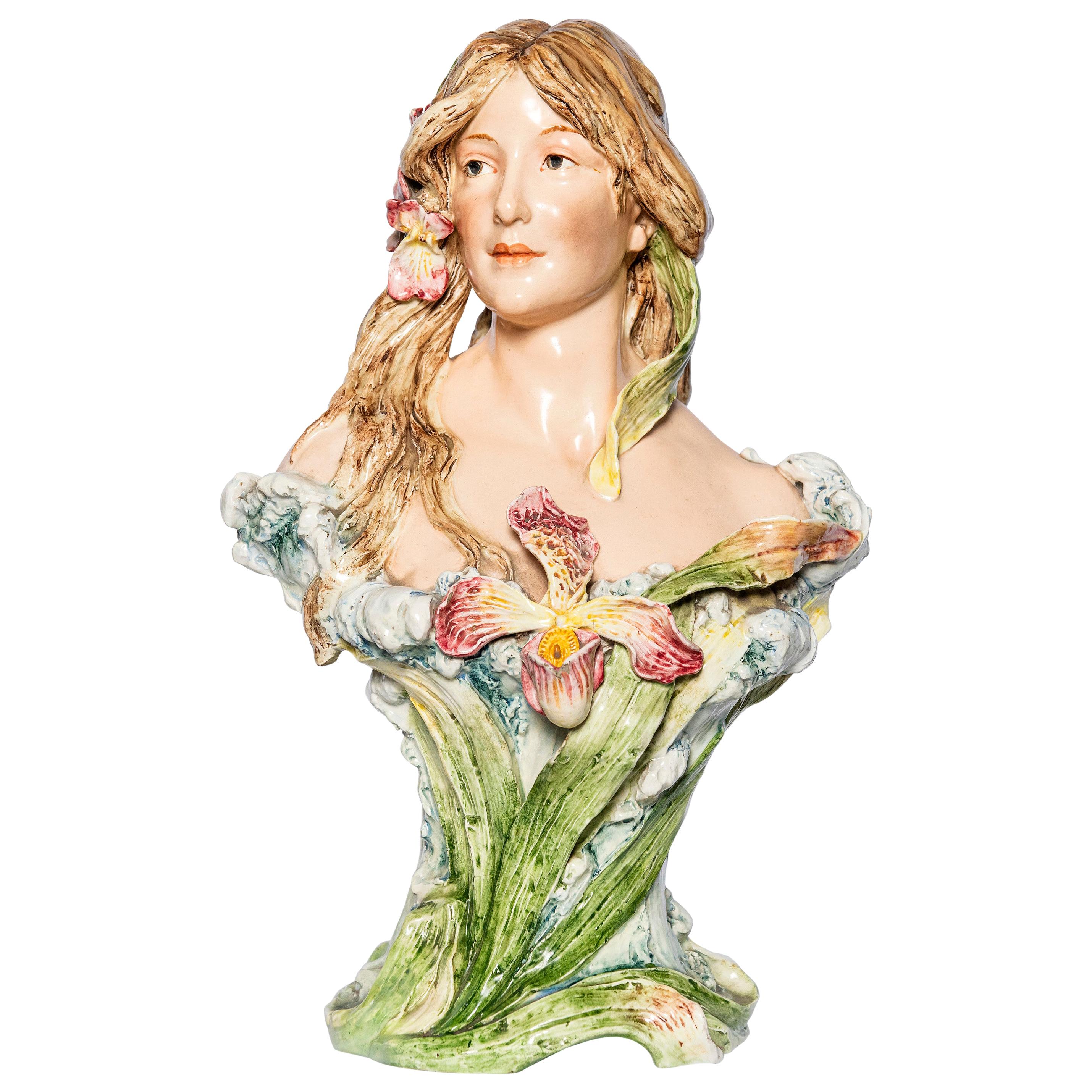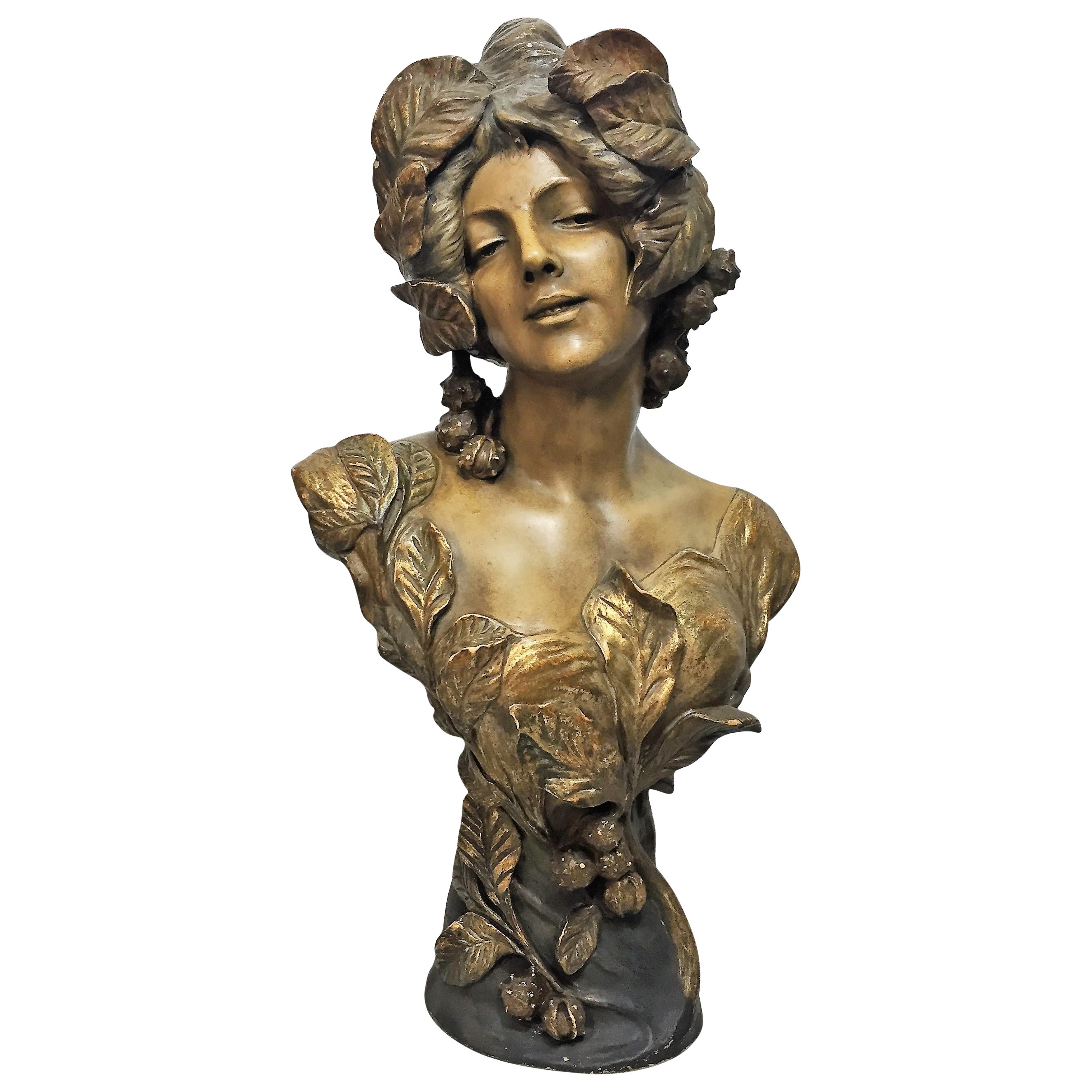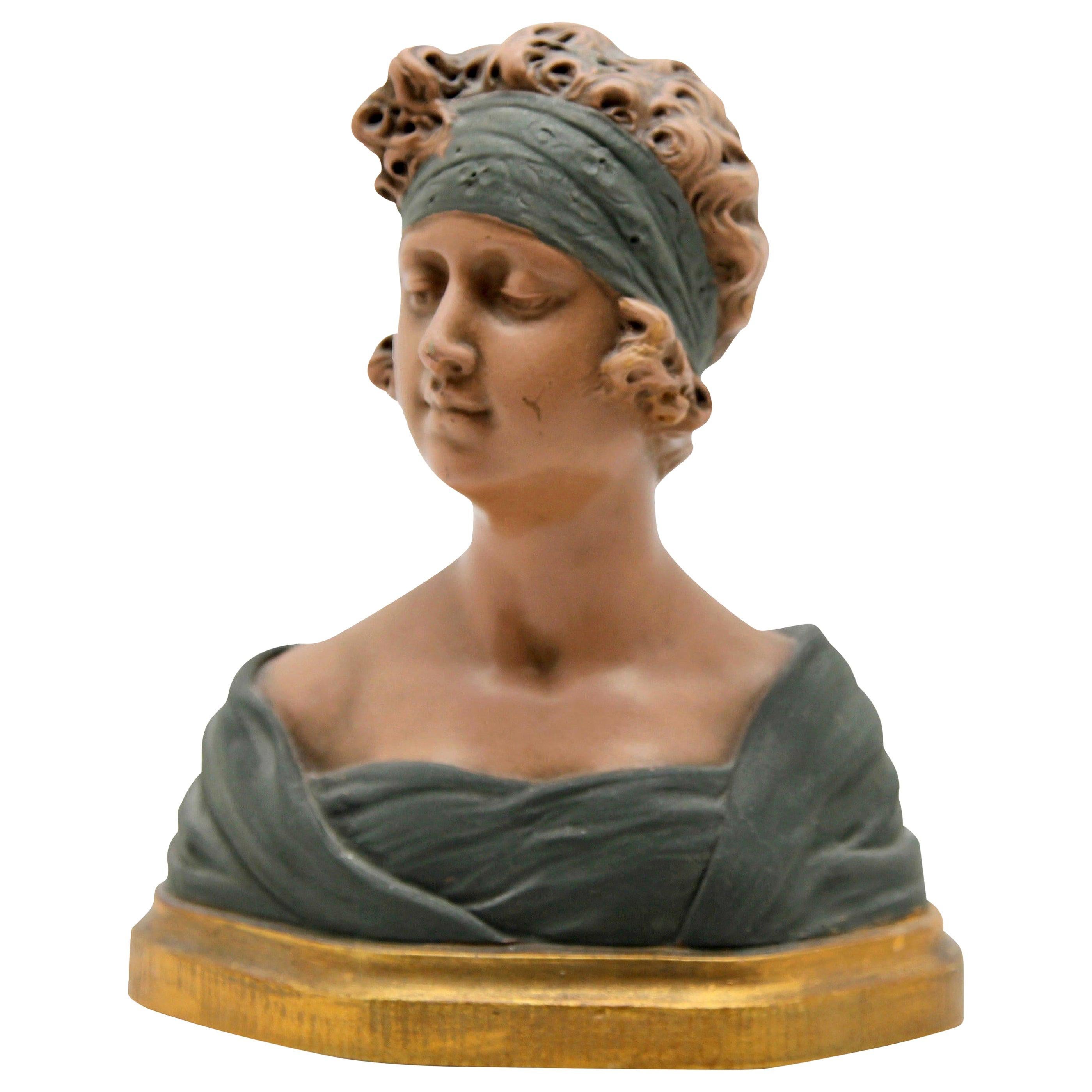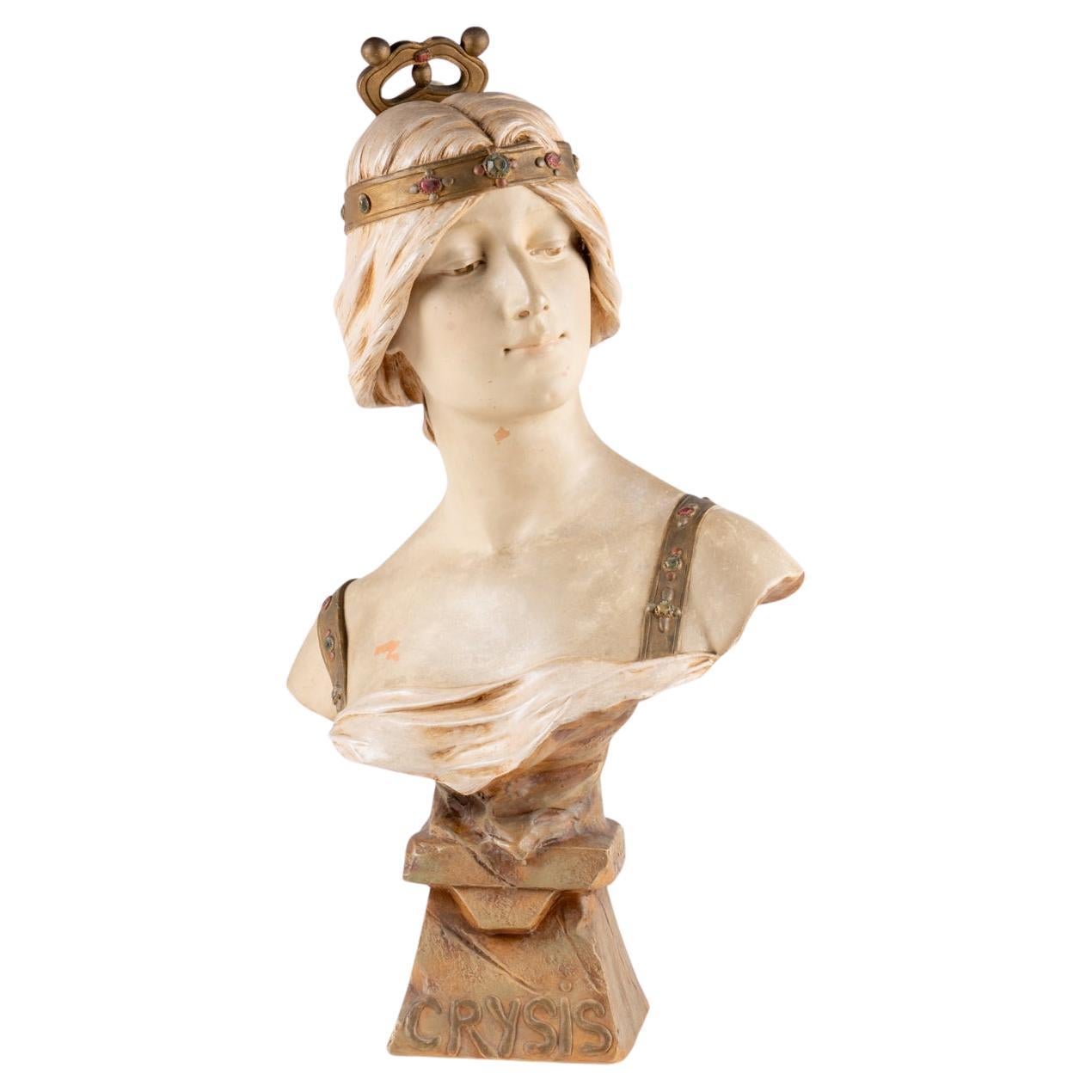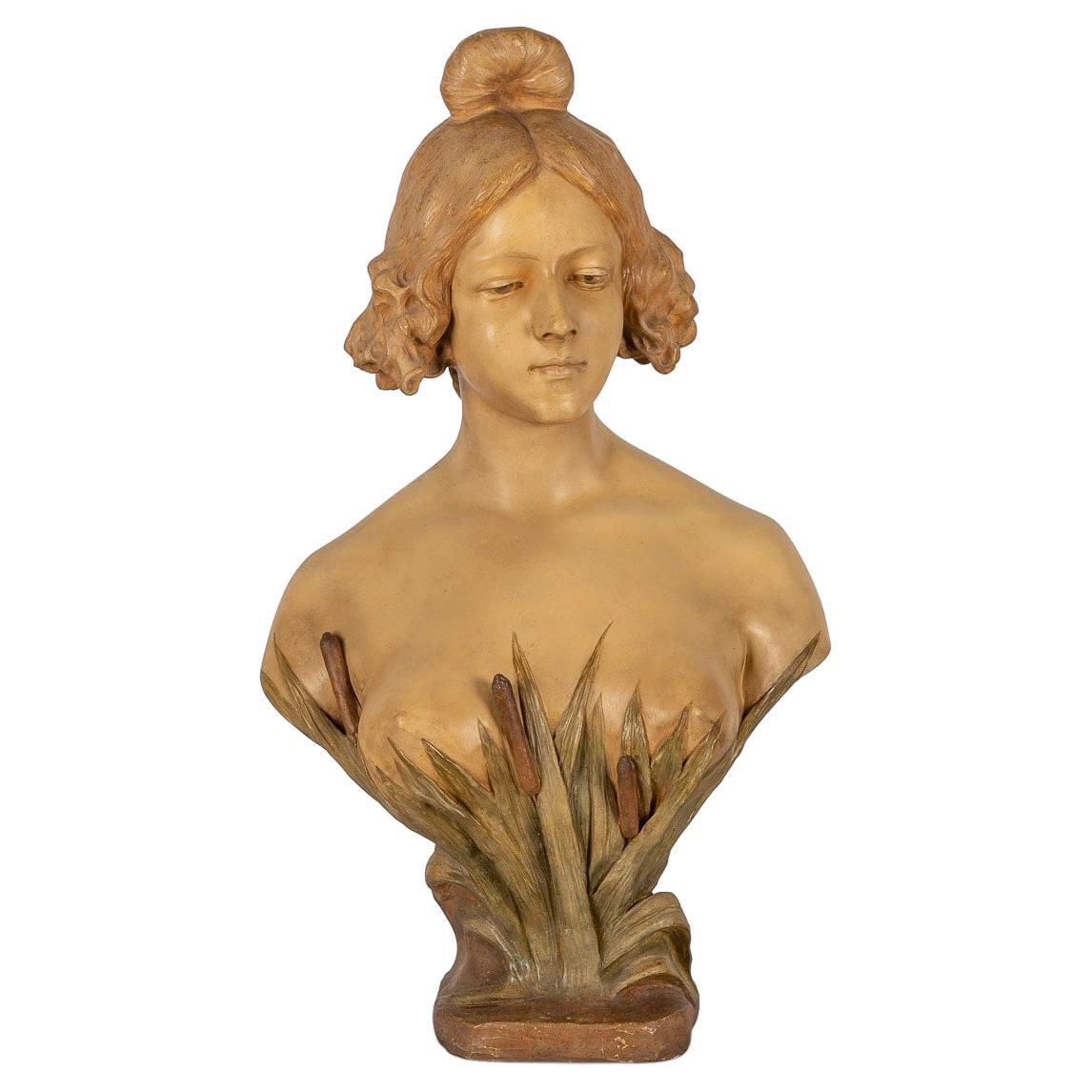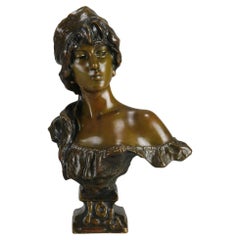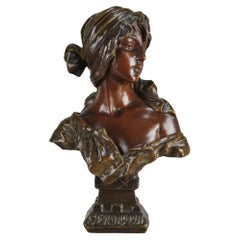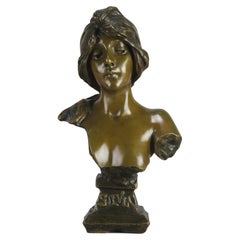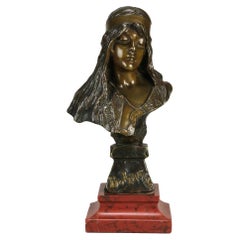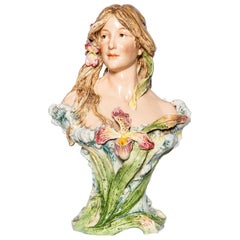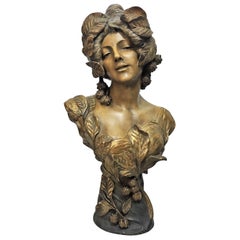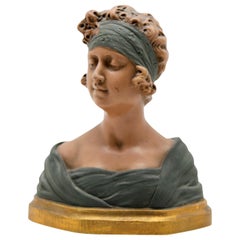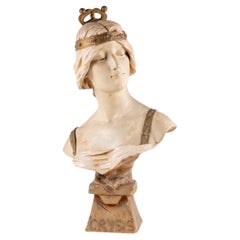Items Similar to Late 19th Century Ceramic Bust entitled "Meditation" by Ernst Wahliss
Want more images or videos?
Request additional images or videos from the seller
1 of 13
Late 19th Century Ceramic Bust entitled "Meditation" by Ernst Wahliss
$1,989.85
£1,450
€1,704.90
CA$2,747.44
A$3,046.70
CHF 1,600.82
MX$37,225.54
NOK 20,028.40
SEK 18,800.08
DKK 12,727.38
About the Item
A beautiful late 19th Century ceramic Art Nouveau bust in muted vellum tones with gilded highlights modelled as an attractive Art Nouveau maiden wearing a floral headdress with excellent colour and detail, stamped to the underside.
ADDITIONAL INFORMATION
Height: 19 cm
Width: 11 cm
Depth: 7 cm
Condition: Good condition with minor signs of wear to surface
Circa: 1890
Materials: Earthenware
SKU: 9222
ABOUT
Ernst Wahliss (Austrian, 1837 ~ 1900) During the late 1880s, Ernst Wahliss had established himself as Vienna's leading retailer for porcelain. In 1863 he opened a shop in Vienna, expanding in 1879 and opening a branch in London. In 1894, he acquired the factory of Alfred Stellmacher in Turn-Teplitz, Bohemia, and began to produce decorative ceramics under the name 'Ernst Wahliss Kunst-, Porzellan und Fayence-Fabrik'. The business was taken over by his sons Erich & Hans. By 1910 the factory at Turn-Teplitz had some 500 employees. The business eventually closed in 1930.
Art Nouveau
Art Nouveau was a movement that swept through the decorative arts and architecture in the late 19th and early 20th centuries. Generating enthusiasts throughout Europe and beyond, the movement issued in a wide variety of styles, and, consequently, it is known by various names, such as the Glasgow Style, or, in the German-speaking world, Jugendstil. Art Nouveau was aimed at modernizing design, seeking to escape the eclectic historical styles that had previously been popular. Artists drew inspiration from both organic and geometric forms, evolving elegant designs that united flowing, natural forms with more angular contours. The movement was committed to abolishing the traditional hierarchy of the arts, which viewed so-called liberal arts, such as painting and sculpture, as superior to craft-based decorative arts, and ultimately it had far more influence on the latter. The style went out of fashion after it gave way to Art Deco in the 1920s, but it experienced a popular revival in the 1960s, and it is now seen as an important predecessor of Modernism.
- Creator:Ernst Wahliss (Artist)
- Dimensions:Height: 7.49 in (19 cm)Width: 4.34 in (11 cm)Depth: 2.76 in (7 cm)
- Style:Art Nouveau (Of the Period)
- Materials and Techniques:
- Place of Origin:
- Period:
- Date of Manufacture:1890
- Condition:Wear consistent with age and use.
- Seller Location:London, GB
- Reference Number:Seller: 92221stDibs: LU3216341562762
About the Seller
5.0
Vetted Professional Seller
Every seller passes strict standards for authenticity and reliability
Established in 1936
1stDibs seller since 2017
84 sales on 1stDibs
Typical response time: <1 hour
- ShippingRetrieving quote...Shipping from: London, United Kingdom
- Return Policy
Authenticity Guarantee
In the unlikely event there’s an issue with an item’s authenticity, contact us within 1 year for a full refund. DetailsMoney-Back Guarantee
If your item is not as described, is damaged in transit, or does not arrive, contact us within 7 days for a full refund. Details24-Hour Cancellation
You have a 24-hour grace period in which to reconsider your purchase, with no questions asked.Vetted Professional Sellers
Our world-class sellers must adhere to strict standards for service and quality, maintaining the integrity of our listings.Price-Match Guarantee
If you find that a seller listed the same item for a lower price elsewhere, we’ll match it.Trusted Global Delivery
Our best-in-class carrier network provides specialized shipping options worldwide, including custom delivery.More From This Seller
View AllLate 19th Century Art Nouveau Bust Entitled "Lola" by Emmanuel Villanis
By Emmanuel Villanis
Located in London, GB
Stunning Art Nouveau bronze bust depicting the character "Lola" modelled in the midst of an inquisitive look. The study has a multi hued patination of colours that accentuate the very fine hand chased surface detail. Signed ?E Villanis...
Category
Antique 19th Century French Art Nouveau Busts
Materials
Bronze
Late 19th Century Art Nouveau Bust Entitled "Cendrillon" by Emmanuel Villanis
By Emmanuel Villanis
Located in London, GB
An attractive late 19th Century Art Nouveau French bronze bust exhibiting deep multi-hued patination and excellent detail. The beautiful character wearing a head dress and a loosely draped blouse representing ’Cinderella’ from the famous French opera. The bronze is signed E Villanis and titled to the fore on its integral bronze base.
ADDITIONAL INFORMATION
Height: 30 cm
Width: 19 cm
Depth: 12 cm
Condition: excellent original condition
Circa: 1890
Materials: Bronze
Book Ref: Emmanuel Villanis by Josje Hortulanus-de Mik
Page No: 35
SKU: 8773
ABOUT
Villanis Cendrillon
Emmanuel Villanis was an industrious man. He is believed to have created some 200 to 250 pieces. His oeuvre pre-eminently consisted of busts and full body statues...
Category
Antique 19th Century French Art Nouveau Figurative Sculptures
Materials
Bronze
Late 19th Century Art Nouveau Bust entitled "Silvia" by Emmanuel Villanis
By Emmanuel Villanis
Located in London, GB
A very fine late 19th century French bronze bust of an attractive classical maiden modelled in the Art Nouveau style, with fabulous multi hued patination of brown and a subtle green, accentuating the excellent hand finished detail. Signed E Villanis, with Societe des Bronzes foundry seal, numbered and with raised title to the fore.
ADDITIONAL INFORMATION
Height: 28 cm
Width: 16 cm
Depth: 10 cm
Condition: Excellent Original Condition
circa: 1890
Materials: Bronze
Book Ref: Emmanuel Villanis by Josje Hortulanus-de Mik
Page No: 79
SKU: 8775
ABOUT
Sylvia Ballet - Silvia
Sylvia, (the spelling is different in french) is a classical ballet. It features a nondescript mythical setting and a late nineteenth-century score, in which it's themes correlate to giving it a more classical feel, however, it was quite revolutionary for its time. The score was and still is recognized for its greatness. Delibes' work is certainly the best appreciated aspect of the ballet for its innovation, creativity, and maturity. Frederick Ashton's choreography complements the music very well in this respect, staying true to the spirit of the original production while incorporating modern techniques and adding his own unique touch.
The ballet itself follows Sylvia who is a loyal follower of Diana (the goddess of the hunting and chassitity). The story starts with Sylvia being stalked by the diety Eros. When she discovers this they fire their bows at each other respectively. However only Eros's shot is true and wounds Sylvia. This is where she is kidnapped by an unknown assailant later revealed to be Orion.
Sylvia escapes the caves of Orion by getting her captor intoxicated and pleading to Eros to rescue her. When he begrudgingly rescues her he takes her to the temple of Diana where her love awaits. This leads her to repeal her oath of Chassity taken as a follower of Diana.
Emmanuel Villanis
Emmanuel Villanis was an industrious man. He is believed to have created some 200 to 250 pieces. His oeuvre pre-eminently consisted of busts and full body statues. Most of these were manufactured in bronze, but there are also models in white metal and terra cotta. Different patinas were used. The bronzes were mainly cast by the Societé de Bronzes de Paris and can be recognised by the round stamp...
Category
Antique Late 19th Century French Art Nouveau Busts
Materials
Bronze
19th Century Art Nouveau Bronze Bust Entitled "Bohémienne" by Emmanuel Villanis
By Emmanuel Villanis
Located in London, GB
Captivating late 19th century French bronze bust of a beautiful woman, enhanced by the variegated rich brown patination and excellent tactile surface detail, raised on an integral bronze base with raised title to the fore. Signed ?E Villanis and further raised on a breche griotte stepped and shaped marble plinth
ADDITIONAL INFORMATION
Height: 33 cm
Width: 16 cm
Depth: 11 cm
Condition: Excellent Original Condition
circa: 1890
Materials: Bronze
Book Ref: Emmanuel Villanis by Josje Hortulanus-de Mik
Page No: 17
SKU: 8616
ABOUT
Puccini's Opera - La Bohème
SYNOPSIS - A group of friends are living a Bohemian life in Paris and trying to make their livings creating art. Rodolfo, the writer, falls in love with the seamstress, Mimi, while Marcello, the painter, and Musetta, the singer, are the on-and-off-again couple by their sides. When the four are happy, they spend their time celebrating life and love. However, Mimi is revealed to be very ill, and Rodolfo struggles to come to terms with the fact that she will inevitably die. Rodolfo and Mimi break up, and months later, Musetta discovers Mimi extremely sick and close to death. She brings Mimi to Rodolfo and Marcello's apartment. Rodolfo immediately takes her in and tries to nurse her back to health, but he is too late. Almost as soon as the two are reunited and have professed their love for one another, Mimi succumbs to her illness and dies.
Emmanuel Villanis
Emmanuel Villanis was an industrious man. He is believed to have created some 200 to 250 pieces. His oeuvre pre-eminently consisted of busts and full body statues. Most of these were manufactured in bronze, but there are also models in white metal and terra cotta. Different patinas were used. The bronzes were mainly cast by the Societé de Bronzes de Paris and can be recognised by the round stamp...
Category
Antique Late 19th Century French Art Nouveau Busts
Materials
Marble, Bronze
Late 19th Century Art Nouveau Sculpture "Nature Unveiling" by Ernst Barrias
Located in London, GB
Wonderful late 19th Century Art Nouveau French bronze figure of a seductively draped female figure representing, in allegorical form, Nature revealing her secrets to Science, a fitti...
Category
Antique Late 19th Century French Art Nouveau Figurative Sculptures
Materials
Marble, Bronze
Early 20th Century Art Nouveau Earthenware "Spill Vase" by Ernst Wahliss
By Ernst Wahliss
Located in London, GB
A beautiful Art Nouveau glazed earthenware spill vase modelled with a figure of a young beauty standing drinking from a shell with a toga loosely draped over her body with excellent ...
Category
Early 20th Century Austrian Art Nouveau Vases
Materials
Porcelain
You May Also Like
Glazed Ceramic Woman Bust, Art Nouveau Period, France, Early 20th Century
Located in Buenos Aires, Buenos Aires
Glazed ceramic woman bust, Art Nouveau period, France, early 20th century.
Category
Early 20th Century French Art Nouveau Busts
Materials
Ceramic
$7,200 Sale Price
20% Off
F. Goldscheider - large woman bust Polychrome Terracotta - Art Nouveau signed
By Friedrich Goldscheider
Located in Beuzevillette, FR
Beautiful terracotta bust from the factory of Friedrich Goldscheider from the art nouveau period. Girl with flowers.
Polychrome terracotta
It represents a female bust with her head t...
Category
Early 20th Century European Art Nouveau Busts
Materials
Terracotta
Auguste Henri Carli Bust in Terracotta, France, Belgium, Early 20th Century
By Auguste Carli
Located in Verviers, BE
Auguste Henri Carli (1868-1930)-bust in terracotta, France, Belgium, early 20th century
Signed A. Carli.
Auguste Carli is a French sculpture, w...
Category
Vintage 1920s Belgian Art Nouveau Busts
Materials
Terracotta
$561 Sale Price
20% Off
Art Nouveau Terracotta Sculpture, Circa 1900.
Located in Saint-Ouen, FR
Art Nouveau terracotta sculpture by Georges Charle Coudrai, circa 1900.
H: 63cm, W: 37cm, D: 30cm
Category
Antique Early 1900s French Art Nouveau Busts
Materials
Terracotta
20th Century French Art Nouveau Terracotta Bust, A Gory, c.1900
By Affortunato Gory
Located in Royal Tunbridge Wells, Kent
Antique early-20th Century French Art Nouveau terracotta sculpture of a female bust. This sculpture is beautifully made with fine detail and with a lovely patination. Signed by the I...
Category
20th Century French Art Nouveau Busts
Materials
Terracotta
French 19th-20th Century Art Nouveau Polychromed Terracotta Bust of "Crépuscule"
By Salesio Lugli
Located in Los Angeles, CA
A fine French 19th-20th century Art Nouveau polychromed terracotta bust of "Crépuscule" (Twilight) After Henri Jacobs (Belgian, 1864-1935) version of Crépuscule, depicting a young ma...
Category
Antique Early 1900s French Art Nouveau Busts
Materials
Terracotta
$4,750 Sale Price
26% Off
More Ways To Browse
Early 20th Century German Ceramic
Glasgow Arts And Crafts
Art Nouveau Maiden
Turn Teplitz
Ernst Wahliss
Teplitz Bohemia
Turn Teplitz Bohemia
Phantom Of The Opera Vintage
African Wood Bust
Antique Marble Head
Augustus Bust
Bronze Bust Patina
Bust Of Homer
Marble Warrior Bust
African Carved Bust
Antoninus Pius
Black Roman Bust
Bronze Bust American
